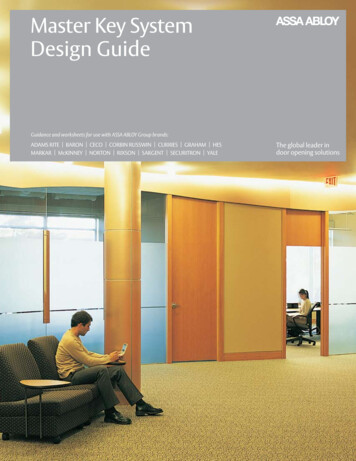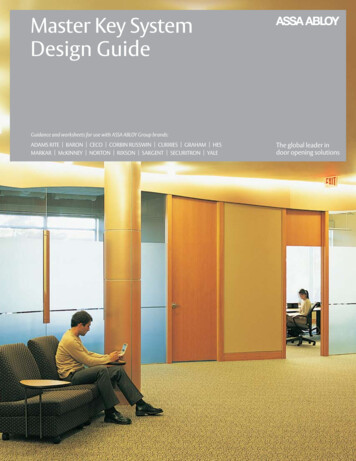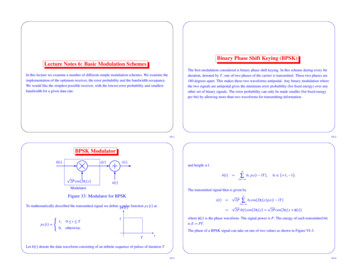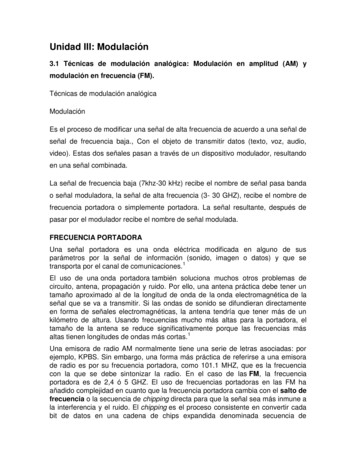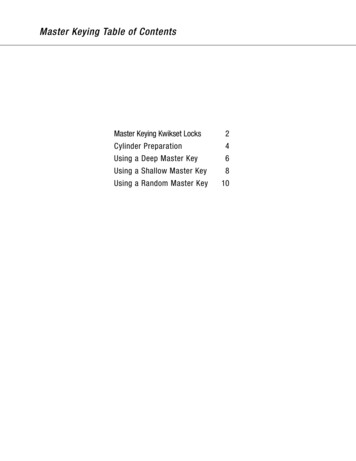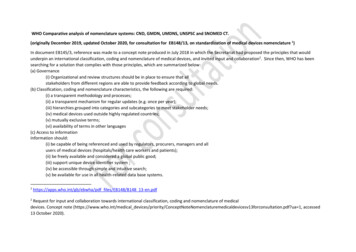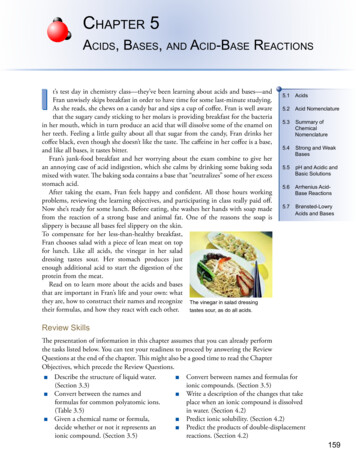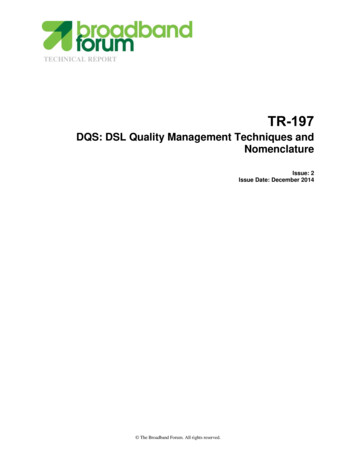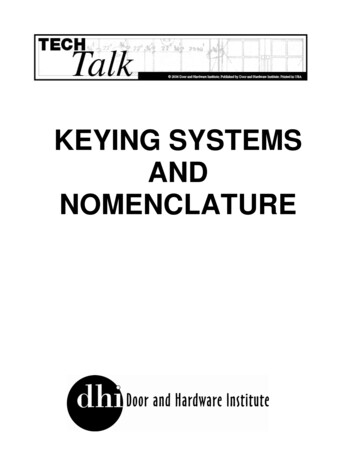
Transcription
KEYING SYSTEMSANDNOMENCLATURE
FOREWORDKeying Procedures, Systems, andNomenclature was first published in1965, revised in 1969, 1975 and againin 1978. It introduced a proceduralsystem of keying terminology radicallydifferent from that commonly usedprior to 1965. The need for standardterminology was clear but theacceptance of the new system wasslow.Manufacturers, Distributors, BuildingOwners,andOperatorswerefrustrated over the use of various anddiffering terms. Among those using theterms,differentmeaningsandinterpretations were applied. As aresult, errors were made, and frequentcorrespondence occurred betweenmanufacturersanddistributors,seeking clarification. The consumersometimeshadasketchyunderstanding of the key system hehad purchased.Since its inception, the proceduresoutlined in this manual have beentaught at the DHI Technical Programsand the results have been gratifying.The use and understanding of thesystem is now close to industry wide,and the authors of the previouseditions should take pride in theresults.There are still some misapplicationsand misunderstandings of the systemand it is the purpose of this edition toclarifythesystemtoavoidmisunderstanding. With this in mind,text and format changes have beenmade with the aim of introducingcriteria in their order of complexity, tomake the manual an even betterinstructional tool for those progressingthrough basic, intermediate, andadvanced study of the subject.Since the manual does not coveractual keying procedures, the title ofthe manual has been changed. Forthose interested in the actualtechniquesofkeyingorthemathematics of setting up a keysystem, many fine books andpublications are offered by the locksmithing industry.Robert Perry, AHC/CDC John R."Jake" Dalbert. AHC RichardHudnut, DAHCCopyright 1989 by the Door and Hardware InstituteFirst Printing 1965Revised 1969, 1975, 1978Reprinted April 1999
INDEXpage:FOREWORD .1INDEX .2CHAPTER 1Planning a Key System .3Basic Facts of Key SystemsSteps to Structure a Key SystemCHAPTER 2System Theory .5Basic Levels of KeyingKey and Cylinder Coding SystemCHAPTER 3Level One System .7No Master KeyCHAPTER 4Level Two System .8Single Master Key SystemExceptions:Omitting the master keyCross keyingCHAPTER 5Level Three System.10Grand Master Key SystemExceptions:Omitting one or more levelsCross keyingMore than 23 master keysLeading Zero'sCHAPTER 6Level Four System.11Great Grand Master Key SystemExceptions:Omitting one or more levelsCross keyingCHAPTER 7School Key System Guidelines.12CHAPTER 8Hospital Key System Guidelines.14CHAPTER 9Hotel Key System Guidelines .15CHAPTER 10Office Building Key System Guidelines .17CHAPTER 11Multiplex Key Systems .18CHAPTER 12Key Control Systems .19Planning a Key Control SystemTips for Setting Up SystemsLock and Key SurveyCHAPTER 13Maintenance of Key Systems .21CHAPTER 14The Key Conference.22Setting up the ConferencePreparing for the ConferenceDuring the ConferenceThe Work SheetCHAPTER 15Key System Limitations .25Key DepthsMathematical LimitationsMultiples of 4CHAPTER 16Recommended Standard Definitions .27
CHAPTER 1PLANNING A KEY SYSTEM"Hardware consultants render one oftheir most useful services by designinga practical and efficient keying systemfor a facility.Because the principles of keying arenot understood by those outside thefield of locks, a consultant's servicesare most valuable in guiding theorganization of keying so it will:1. Function properly2. Be easy to understand3. Be practical enough to surviveyears of usage4. Providethesecurityrequired by the userThe keys in a keying system relate toeach other and to the system as awhole. This relationship restrictskeying options and the flexibility of thesystem design.Keep It SimpleThe more complicated the design ofthe keying system, the shorter itsusable life. Key a building to performits function. Do not key it to individualson an organization chart. Personnel/People relationships and organizationschange rapidly. Building functionssurvive for many years. An intricatesystem, misunderstood by the owner,usually degenerates quickly. The resultis usually that everyone ends up with amaster key.BASIC FACTS OF KEY SYSTEMSBreak Up Very Large SystemsThe following basic facts applyregardless of the manufacturer, type ofcylinder, or key involved in the system:It is unwise to tie too much togetherunder one "top" master key. If the "top"key is compromised (loss, theft,duplication, decoding), the entiresystem must be rekeyed.Security Is Inversely Proportional toConvenienceA cylinder operated by a single key ismost secure. Each additional keyoperating the same cylinder increasesthe number of shear lines. Thisreduces the security of the cylinder bymaking it easier to pick or be openedby unauthorized keys.Durability Is Affected by the Level ofKeyingA cylinder operated by a single keylasts longest. Each additional keyoperating the same cylinder requires more master pins of differentincrements. The number of masterpins increase with each successivelevel of keying. This causes greaterwear and increases the chances ofmalfunction of the cylinder.There are LimitationsThere are a limited number of change,master, and grand master keys thatcan be established within a keyingsystem. This limitation is physical andmathematical in nature and existswithin all systems. Systems designedto be expanded the least are generallythe most secure. It is important to berealistic in establishing the degree offuture expansion. (See Chapter 15 fora better understanding of a system'slimitations).Keys Relate to Each OtherSTEPS TO STRUCTURE A KEYSYSTEMResearch the Building FunctionHow, when, and by whom will it beused? Buildings are designed to servea function. Study the function of thebuilding, the flow of traffic, the purposeof various areas. Design the keyingsystem to accomplish these purposes.Try to visualize the category of peopleby their function, the areas they mustreach to perform their duties and thedifferent times in a working day whenthese perform specific duties. Try toimagine where they must move, whenand how. Remember also that aproper keying system is based on thebuilding function, not personnel.In most structures there are relativedegrees of security to be considered insetting up the keying. Again, using ahospital illustration, narcotics lock-upand operating room facilities carry ahigh security classification. Security ispartially achieved by greatly limitingthe number of keys to an area and insome cases, limiting operation of acylinder to a single change key,perhaps even a special high securitycylinder.In considering the function of abuilding, study how it relates toexisting structures and plans for futurestructures. Keep building areas of thesame function under the same keyinghierarchy.Prepare a Schematic Diagram of theProposalSuggest an appropriate keying system,based on building function.Bring the study into focus and beginto diagram a concept of how thekeying system will work. Like manythings, real success comes in beingable to simplify what would appear tobe a complex system. It takes verylittle talent to make complex keyingschedules.Diagram the schedule, and look forevery opportunity to use the samechange key on as many doors aspossible. Where doors have similarpurpose and will be used by similartype people, key them alike.As a first rule, use the lowest level ofkeying possible until the system forcesyou into a higher level. There will bemany doors where logic tells you nochange key will be used. In situationslike this, it is appropriate to masterkey(no change keys) only.Remember the limited availability ofdifferent change keys and use themsparingly. The owner will thank you inyears to come as this will leaveflexibility in the system. Minor additionsand modifications can be made underthese conditions without redoing theentire system.Don't start out with a preconceivednotion over the necessity of a greatgrand or grand masterkey. Build fromthe bottom up and let requirementsdictate where it is appropriate toestablish higher key levels. Key thebuilding and not the people.Do not be concerned if some peoplehave to carry two or more keys. This isfor more preferable than having asystem where a key operates cylindersunderdifferentmasterkeys.Ifuncontrolled crosskeying is permitted,it rapidly eliminates available changekeys which must be discarded and notused in the system. Intricate systemscan be made secure but more oftenthan not, prove to be unnecessary anddifficult to maintain.Present the Proposal.(See Chapter 14 for additionalinformation about the Key Conference)The Schematic diagram is the toolfor selling the system.Present the system to the owner'srepresentative. It is most effective touse the alpha-numeric designation andthe schematic charts as explained andillustrated in this booklet. Explain theconcept of the function and traffic flowof the building as you have analyzed3
and conceived it. Typically, there willbe attempts by the owner to introduce"people keying". Try to deal with theseintelligently and discourage themwhenever possible. Usually an ownercan understand that people and theirrelationship to the building aretemporary in nature. There is noquicker way to nullify a keying systemthan have it oriented around existingpeople. In the presentation, beprepared to explain and recommendsome of the many options available inkeying systems such as visual keycontrol, interchangeable or removablecore cylinders, and constructionkeying. It is your obligation to presentboththeadvantagesanddisadvantages of these options, thenlet the owner decide those ofimportance.Accept InputConstructive corrections may beoffered. After the presentation, listen tothe desires of the owner. Remember,the building is his, not yours. Acceptandaccommodatereasonablesuggestions which will make thesystemworkablefromanadministrative standpoint.Make a Final Detailed KeyingSchedule for the ManufacturerReduce information developed duringthe planning sessions to a final door bydoor keying schedule for the use of thelockmanufacturer.Thekeyingengineers at the lock company shouldreview the schedule to assure itspracticality. Include all references andregistry numbers of any existing keyingif the project includes extension to asystem which is in existence. This isparticularly necessary if previousorders placed with the manufacturerused different group or keyingdesignations from the schedulecurrently being prepared.If the initial order had, for example, akey group AB15, make sure that youraddition does not use the samedesignation unless you wish it to bekeyed alike. The same would apply togrand master (A, B, C, etc.) or master(AA, BB, CC, etc.) designations.Use the uniform keying designationsin this manual. All major lockcompanies are familiar with them andunderstanding by everybody involvedin the supply of locks, cylinders, andkeys will be greatly improved as aresult.Requirements should provide for thebuildingorbuildingspresentlyproposed and also take care of anyfuture building additions which mightbe contemplated by the owner.Complete the Schematic DiagramPrepare a final schematic chart of thekeying system after it has beenacceptedbythehardwaremanufacturer. This chart should ossession of the building(s) so it canbe retained in the files. This amountsto a blue print of the keying system forfuture reference if additions orchanges are to be made.Whether a key system is modest orlarge, simple or intricate, added to ornot,theultimatecontrolandresponsibility is finally and irrevocablydetermined by the user. The owner oruser should understand clearly fromthe initial concept to the finalacceptance of the keys what thesystem will accomplish, and that keysshould be under complete control ofresponsible personnel.4
CHAPTER 2SYSTEM THEORYBASIC LEVELS OF CONTROLThe establishment of the proper levelof control for key systems is extremelyimportant. Only when this level hasbeen determined, are you ready to layout a system. One of the main reasonsmany key systems disintegrate is theywere not planned at the proper level inthe beginning.Figure 2a illustrates the maximum number of levels the majority of projects will require.Succeeding pages will illustrate the development of these levels.5
Level OneNo Master KeyCylinders are operated by individualkeys only, keyed different, or keyedalike as required.Examples: Homes, small stores.Level TwoMaster KeyCylinders are operated by a changekey and a master key.Key symbols using this nomenclaturesystem automatically indicate thefunction of each key in the es:Elementaryschools,apartments, industrial buildings.Cylinders:When applied to the cylinder, thesymbol will indicate which keys willoperate that cylinder, usually withoutfurther explanation. An exception iswhen the cylinder is cross keyed.Cross keying will be discussed later.All cylinders with the same symbol arekeyed alike.Level FourLevel ThreeGrand Master KeyCylinders are operated by a changekey. a master key and a grand masterkey.Examples: Officeschools, hospitals.buildings,largeGreat Grand Master Key Cylindersoperated by a change key, a masterkey, a grand master key and a greatgrand master key.Examples: Very large Y ANDSYSTEMCYLINDERCODINGLETTERS MASTER KEYINGNUMBERS CHANGESNote: In extremely rare instances,large systems may require 5 or morelevels. Because these systems arerare, they will not be discussed in thisbook. Contact your lock manufacturerfor assistance if a level five system isrequired.Keys:6
CHAPTER 3LEVEL 1 SYSTEM(NO MASTER KEY)No Master Key. Cylinders can be keyed different or keyedalike as required. All cylinders with same identification arekeyed alike.Figure 3aIt is also permissible to use the terms KA or KD forkeyed alike or keyed different. Be aware that a problemmight arise if you have KD1 and then want anothercylinder keyed the same. It will be necessary to go backand change the KD to a KA set.The use of the terms, Set 1, Set 2, Set 3, etc. is alsopermissible.KA1 - Doors 123, 127, 218KD - Door 125KA2 - Doors 129, 208Either is acceptable. Schedule musthave description to explain.TYPICAL SCHEDULE FOR LEVEL 1Door1234From/ToExit/Living RoomExt/KitchenGarage/KitchenDen/Gun ClosetHdwe Set1123Key Set1112OptionalKey SetKA1KA1KA1KDRemarksSecurity DoorSet 1 - Doors 123, 127, 218Set 2 - Door 125Set 3 - doors 129, 208Alternate method used by some lockmanufacturers.Figure 3bFigure 3cCHAPTER 4LEVEL 2(SINGLE MASTER KEY SYSTEM)The master key symbol consists of two letters (AA). Thechange numbers come first. If there is more than one master7
key system, not connected in any way, the master key symbolscould be made up of different sets of two letters (AB, AC, etc.)for convenience in distinguishing between the differentsystems.Examples: Food storage rooms Narcotics cabinetsExample: The first system has a master key with 100 changes.Order cylinders keyed to 1AA through 100AA and the masterkey is AA.The second system, completely separate from the first,requires a master key with 50 changes. Order cylinders 1ABthrough 50AB and the master key is AB.Numbers before letters in a single master key system.Cylinder operated by master key only. (Omitting the changekey).A cylinder operated by the master key only (no change keys),use the master key symbol alone.Example: AACylinder not master keyed but same change key as anothercylinder that is master keyed. (Omitting the master key). Usethe symbol of the other cylinder but add NMK (no master key)after the symbol.Example: 1AA (NMK)Cross Keyed Cylinders(Use Symbol X)In a single master key system, prefix the change number.1changenumberAAmasterkeyEXCEPTIONS TO SINGLE MASTER KEYED SYSTEMOmitting a Level of KeyingSingle keyed (omitting the master key)Used for locks that are keyed different or keyed alike, but notoperated by the master key.The cross key symbol "X" is used when more than one key ofthe same level is to operate an individual cylinder. "X" requiresa written explanation of the cross keying situation. Note:Symbol "X" applies to cylinder only, not to keys.When an individual change key is required for the cylinder:Prefix "X" to the symbol for the cylinder.Example: X1AADescribe what other key or keys will also operate thecylinder.Example: X1AA operated by 1AA, 2AA, AA.In this example, cylinder X1AA will be operated by its ownchange key 1AA, master key AA and also change key 2 A A.*Example: X5AA operated by 5AA, 6AA, 7AA, 10AA, AA. Inthis example, cylinder X5AA will be operated by it's ownchange key 5AA, master key AA, and also change keys 6AA,7AA, and 10AA.**Some Manufacturers: X1AA operated by 2AA. Since 1AAand AA are already included in the symbol, it is not necessaryto list them again but it is best to list ALL keys to avoidconfusion.Keep in mind! Crosskeying should not be altered or added toan existing system. Crosskeying sets are determined first andother keys that will operate the cylinder are eliminated whenthe system is established. Any alterations at a later time mayallow other existing keys to operate the cylinder.When an individual change key is not required, the cylinderis considered "special" and is designated by a number with X'son both sides. A full explanation is then required.8
by change keys 1AA and 2AA, andmaster key AA. No change keys will beissued with cylinder X1X.TYPICAL SCHEDULE FOR LEVEL 1Maison KeyingDoor1From/ToExt/VestibuleHdwe Set1Key SetXIX231215Corr/Apt. 1Corr/Apt. 2Corr/JanitorExt/Trash Bin226111AA2AA10AAX12AA16Corr/High 17RemarksOperated by1AA thru 10AA, AAA specific kind of cross keying where acylinder is operated by all (or a largenumber of) keys. There is very littlesecurity in a maison keyed cylinder.Operated by10AA, 12AA, AAFigure 4cExample: X1X, X2X, etc. X1X to beoperated by 1AA. 2AA, AA. In thisexample, cylinder X1X will be operated9
CHAPTER 5Cylinder operated by change keyand a master key (omitting grandmaster key).LEVEL 3(GRAND MASTER KEY SYSTEM)Prefix change number as in a level 2master key system.Example: 1AA, 2AA, etc.The grand master key is assigned oneletter (A). The master keys under thegrand master are assigned two letters,the first of which is the same as thegrand master.Cylinder operated by Grand Masterkey only (omitting change and masterkey).Use Grand Master Key symbol only.Example: ACylinder operated by Grand Master &Master keys only (omit change key).Use Master Key Symbol.Example: AACylinder keyed alike to anothercylinder except master key is not towork in this cylinder.Use same cylinder nomenclatureexcept add NMK (No master key).Example: AA1 (NMK)Cross Keying:Same as for level 2 master keysystems.More Than 23* Master Keys Under 1Grand Master Key*The letters I, 0, & Q generally are notusedbecausetheycanbemisinterpreted as numerals.When a System requires moremasters beyond AZ, a number isinserted between the letters to indicatehow many times through the alphabet.Example. A2A, A2B, A2C.A2Z, A3A,A3B.A3Z.Leading Zero'sEXCEPTIONS TO GRANDMASTER KEY SYSTEMS:Many distributors and manufacturersuse data processing equipment whichrequires a specific number of spacesfor each key or cylinder designation. Itis permissible to add leading zero's tothe keyset or cylinder designationwhen required. For example: AA001.,AB046, 001AA.Omitting One or More Levels:Single keyed: (omitting the master andgrand master)Used for locks that are keyed differentor keyed alike but not operated by themaster key or grand master key.Examples:Food storage roomsNarcotics cabinetsCylinder operated by a change keyand the Grand Master key (omittingthe master key).Use Grand Master key plus changenumber.Example: A1, A2, etc.10
CHAPTER 6LEVEL 4(GREAT GRAND MASTER KEY SYSTEM)Figure 6aThe Great Grand Master Key system is treated like multiple Grand Master Keysystems. Each GMK system starts with a different letter (A, B, C, etc). The Great GrandMaster Key is assumed to operate all cylinders.EXCEPTIONS TO GREATGRAND MASTER KEY SYSTEMSAll exceptions that apply to a GMK system also apply to a GGMK system. Cylinderskeyed to the GGMK only, use GGM.Example: GGMCylinders keyed to a change key and theGGMK (No MK, No GMK), use GGM andthe change number.Example. GGM1, GGM2Cylinders keyed to a change key and aGMK (no GGM, no MK), Prefix number anduse single letter.Example. 1A, 2A, 1B, 2B11
CHAPTER 7SCHOOL KEY SYSTEMGUIDELINESEstablish the Level of KeyingSchools are unique in that they areusually part of a large GGMK systemunder the control of a centraladministration. When bidding a schoolproject, it is extremely important toverify if a restricted keyway is involvedbecause many manufacturers chargemore for their restricted keyways.Schools often will require high securitycylinders for their buildings to protectagainst theft and vandalism. The gradelevel of the school should beconsidered. An elementary schoolusually does not need more than amaster key. A middle or high schoolwill often require only a master key.The most desirable system is simple,secure and convenient. The schoolshown in figure 7a could be keyed inseveral different ways.MASTER KEY (LEVEL 2)Classrooms and CommonEmployee Areas 1AAPrincipal's Office AAMechanical/Custodial2AALibrary 3AAActivity 4AAMultipurpose Room(Gym, Cafeteria, Auditorium)5AAKitchen 6AAOffice Area7AAExterior Doors8AAGRAND MASTER KEY - PART OF ALARGE DISTRICT (LEVEL 3)Assume Grand Master is Aand Master is AG.All Classrooms and CommonEmployee AreasAG1Principal's G4Multipurpose Room(Gym, Cafeteria, Auditorium)AG5KitchenAG6Office AreaAG7Exterior DoorsAG8 or A5Both examples require personnel tocarry two keys, the exterior door keyand the key for their area of use.Persons carrying the master key willneed only the master as it will operate.all cylinders if AG8 is used for theexterior doors. The use of A5 (changeunder the grand) can be used for theexterior doors. If the building needs tobe rekeyed for security reasons, onlythe exterior doors need to be changedto the next available change under thegrand with no effect on the rest of thesystem.GREAT GRAND MASTER KEY (LEVEL 4)If a school is a larger high school, and a district key (GGMK) is used, then:(Assume GM-B, M-BC)Exterior DoorsPrincipal's OfficeOffice AreaTeachers' Lounge,Workroom, Faculty RestroomsMechanical/CustodialKitchenMath Dept.English Dept.Fine Arts Dept.History/Social StudiesScience Dept.Physical Education (Boys)Physical Education (Girls)Art Dept.Music Dept.Drivers EducationBusiness Dept.Kitchen Dry Food StorageOutside Gym door for communityPoolWood ShopWelding ShopBuilding Trades ShopAuto ShopGraphic Arts (Print Shop)Gym DoorsB1BCBC1(change under the GMK)B1(change under the 1(single keyed different)SKD2(single keyed different)BC14BC15BC16BC17BC18BC19X1X, OB, BC8, BC9, BC, B, GGM12
If the system allows a GMK to be used at the same school, the system shown in theschematic drawing (Figure 7c) could be used. (Assume GM-A)Several things are apparent in this schematic drawing.1. All persons except those carrying the GMK will require two keys, the Al (exteriordoors) and the key for their area of use.2. The system is more complex and there is a possibility that the administration couldlose control if they are not properly educated by the Hardware Consultant.3. Crosskeying was used in the admin office area as a convenience to the users ofthat area. Security has been reduced in those cylinders. An explanation of thecrosskeying was included and completely explained to avoid any confusion.4. Supplying the end users with a schematic drawing can simplify the under standingof the system.All LocksExterior Doors, Restrooms,Lounge, WorkroomPrincipals OfficeOffice EntryOffice StorageCopy Machine RoomTelephone ClosetsElectrical ClosetsCustodians OfficeCustodial Closets,Outdoor StorageAA1AAAA1AA2AA3A2A3AB1AB2Food Service EntryAC1Kitchen OfficeACFreezerAC2Kitchen Equipment StorageACSServing Line DoorsAC4Math Classroom 15AD1Math Classroom 17AD2Math Classroom 18AD3Math Classroom 19AD4English Classroom 16AE1English Classroom 14AE2English Classroom 13AE3English Classroom 12AE4Stage DoorsAF1Fine Arts OfficeAFDressing RoomsAF2Prop StorageAF3Control BoothAF4Social Studies Classroom 10AG1Social Studies Classroom 11AG2History Classroom 22AG3History Classroom 23AG4History Classroom 24AG5Science LabAH1Science Classrooms 25/26/27AH2Science Material StorageAHScience OfficeAHScience GreenhouseAH3Physics LabAH4Gym Doors, Pool DoorsAJ1Girls P.E.AJ2Boys P.E.AJ3P.E. StorageX1X(To be operated by:AJ2, AJ3,AJ, A, GGM)Boys Varsity Sports StorageAJ4Art Classroom 29AK1Art Classroom 30AK2Art Supply StorageX2X(To be operated byAK1, AK2,AK, A, GGM)Kiln RoomAK3Art OfficeAKArt Classroom 31AK4Art Classroom 32AK5Band RoomAL1Instrument StorageAL2Band OfficeALChoral MusicAL3Sheet Music StorageAL4Choral Music OfficeALDrivers Ed. ClassroomAM1Drivers Ed. SimulatorsAM2Drivers Ed. StorageAM3GarageAM4Business Classroom 41AN1Business Classroom 42AN2Typing ClassroomAN3Business StorageAN4Computer ClassroomAN5Wood ShopAP1Welding ShopAP2Building Trades ShopAPSAuto ShopAP4Graphic Arts ShopAP5Kitchen Dry Foods StorageSKD1Chlorine StorageSKD213
CHAPTER 8HOSPITALGUIDELINESKEYSYSTEMExplanation of Visual ChartThis keying is designed for an averagehospital using a Grand Master Keysystem with four control areas, eachhaving its own Masterkey.may also be placed under acompletely separate Masterkey whichis not part of the GGM system. Thiswould constitute a new simpleMasterkey system.)2. It is assumed the Administratorwants a higher degree of privacy forhis or her office.NarcoticsFood StorageAdministratorGift ShopAll LocksEngineers KeyHousekeepers ster Key GroupsClinicalNursingPhysical TherapyOccupational TherapyDieticianPharmacyIntensive 1AC2AC3AC4ACSMaterial ServicesReceivingCentral SupplyFlamable StorageCentral KD2A1A2Engineers and Housekeepers KeysOperating in all four areas are theEngineer's key and the Housekeepingkey as shown directly under the GrandMasterkey. Incorporating these keys atthis point avoids the necessity of crosskeying, e.g. XAA10 to Operate AA10,AA1, AA6, AA, A.Mechanical Area KeysKey alike in sets all janitor closets,telephone equipment areas, electricalequipments areas, and elevatorequipment areas. This limits the usageof the two powerful Engineers andHousekeeping keys. In areas where itis not desirable for the Engineer's keyor the housekeeper's key to operate,this should be spelled out in the keyingschedule, e.g. A, AA and AA1 only.Security Area KeysGrand Masterkey A operates allcylinders in the system except forSKD1 (Narcotics) and SKD2 (FoodStorage.) In some areas of a hospital,it is mandatory that only one person beresponsible and accountable for thelocked items.Figure 8 shows the symbol SKD1(Narcotics) and SKD2 (Food Storage).SKD indicates "single keyed different".There can be other locks in a hospitalthat should be keyed in this manner.The physical number of keys to befurnished for each SKD lock or groupof locks must be indicated on thekeying schedule and instructions to thelock manufacturer. The SKD symboleliminates all other keys up to andincluding the Great Grand Masterkey.Omitting the Master KeyA1 and A2 are operated only by A1and A2 respectively and GrandMasterkey A. The intent here is tobypass any master key because:1. The Gift Shop is leased to anoutside vendor and only under mostunusual circumstances would anyonebut that vendor have access. (At theowner's direction, the Gift/Retail AreaGrand Masterkey A, Masterkey AAand change keys AA1 through AA6operate cylinders within the Med./Surgical area. Grand Masterkey A,Masterkey AB and the listed changekeys (except SKD1) operate cylinderswithin the clinical area and so on.Key ControlWith a key system of this size, it isessential that a good key controlsystem be supplied and properly setup in the administrative offices. Asatellite system should also beinstalled in the engineer's office forstorage of original keys (for makingduplicate keys) and issuance of"loaner" keys to telephone companyand other service personnel. Ideally,the key control systems will be set up(keys tagged, indexed, and hung in thecabinet) by the hardware supplier andat least one hospital staff member.When done in this manner, the staffmember becomes familiar with theoperation of the key control s
FOREWORD Keying Procedures, Systems, and Nomenclature was first published in 1965, revised in 1969, 1975 and again in 1978. It introduced a procedural system of keying terminology radically
